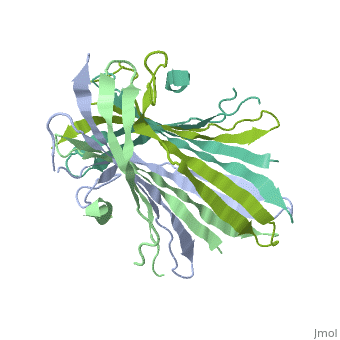User:Vinícius M. Neto/Sandbox 1
From Proteopedia
(Difference between revisions)
| Line 6: | Line 6: | ||
== Basic structure == | == Basic structure == | ||
| - | The N-Terminal domain of the fibroin heavy chain (fibNT) is a homo 4-mer with mostly <scene name='10/1082417/Hidrophilic-phobic_aas/1'>hidrophilic amino acids</scene> (<font color=" | + | The N-Terminal domain of the fibroin heavy chain (fibNT) is a homo 4-mer with mostly <scene name='10/1082417/Hidrophilic-phobic_aas/1'>hidrophilic amino acids</scene> (<font color="maroon">'''hidrophilic amino acids in marron'''</font> and <font color="mediumblue">'''hidrophobic in medium blue'''</font>) |
| - | == | + | |
| + | <scene name='10/1074499/Hbonds/1'>TextToBeDisplayed</scene> | ||
| + | |||
| + | == Oligomerization == | ||
| + | |||
| + | At a neutral pH, the FibNT exists in a random coil state, which prevents premature formation of β-sheets. As the pH decreases to around 6.0, FibNT undergoes a structural transition to form β-sheets. This pH drop mirrors the natural process occurring as fibroin moves from the posterior to the anterior silk gland of the silkworm.FibNT undergoes a conformational change from a random coil to β-sheets when the pH decreases to around 6.0. This transition is critical for dimerization and subsequent oligomerization. | ||
| + | |||
| + | |||
| + | Dynamic light scattering (DLS) and electron microscopy (EM) show that FibNT forms micelle-like oligomers as pH decreases. This suggests that FibNT acts as a pH-sensitive module, initiating self-assembly under acidic conditions similar to those in the silk gland lumen. | ||
| + | |||
== Relevance == | == Relevance == | ||
Revision as of 02:03, 18 June 2025
Your Heading Here (maybe something like 'Structure')
| |||||||||||
References
- ↑ Hanson, R. M., Prilusky, J., Renjian, Z., Nakane, T. and Sussman, J. L. (2013), JSmol and the Next-Generation Web-Based Representation of 3D Molecular Structure as Applied to Proteopedia. Isr. J. Chem., 53:207-216. doi:http://dx.doi.org/10.1002/ijch.201300024
- ↑ Herraez A. Biomolecules in the computer: Jmol to the rescue. Biochem Mol Biol Educ. 2006 Jul;34(4):255-61. doi: 10.1002/bmb.2006.494034042644. PMID:21638687 doi:10.1002/bmb.2006.494034042644

